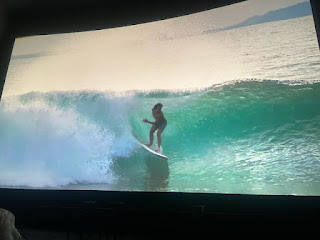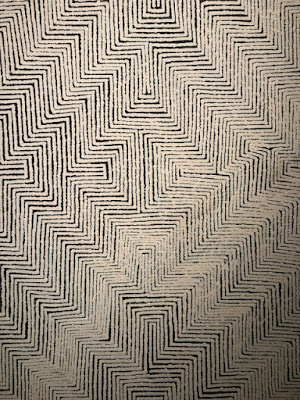The button on the film festival website is now working and you can buy all film passes. Last year the new directors of the AIFF Pat McGee and Adam Linkenhelt did away with all film passes altogether. There was some pushback and some were made available. I was told there will be a limited number of passes this year. The price is $200 each, considerably more than in the past. That's still a lot cheaper than buying tickets one-by-one if you're going to as many films as you can. There are a number of folks who have been doing that for many years. It's still not clear on the website a) how to buy individual tickets for events, or b) how much they will cost this year. [UPDATED: Nov 19, 2025 - You can purchase tickets for individual showings for $12. So if you're going to see more than 16 events a pass is the way to go. And you don't have to buy tickets each time. In the past you did have to get tickets at the Bear Tooth by showing your pass. (You could do one Friday, five on Saturday, Sunday, and Monday each. There are more showings than that, but they are at the same time.)]
But if you want a festival pass, I suggest getting on the website and scrolling down until you see the link to buy passes.
This year there are a lot of films showing at the same time. If you have a lot of programs (showings of a feature film, or showing of a block of shorts) this will, inevitably happen. But looking at Monday's programming, both the Alaska Experience Theater and F Street Theater have 10:30am and 1 pm showings. Bear Tooth has a 5:30 showing. So one of the downtown venues could have started at 10:30am and the other at noon, with a 2:30 or 3pm showing. Then there would have only been one overlapping event. The second Saturday, they have spaced things out so there is no overlap.
I'd also note that on Thursday, December 11 in the online schedule as of my writing this, at 7:00 30 pm in the Museum it says: "Jewish Museum Feature." I'm guessing that was a place holder until the webmaster got the name of the film. I spoke to the director of the Jewish Museum here in Anchorage and she said the film was:
Plunderer: The Life and Times of a Nazi Art Thief - Hugo MacGregor.
 |
| Image from 7th Art |
From MFABoston:
“'It’s not every day that you meet an old Nazi.' So begins historian Jonathan Petropoulos, recalling the day in 1998 when he first met Bruno Lohse, Hermann Göring’s art agent in Paris during World War II. Once an obscure art dealer, Lohse rose to prominence in Göring’s inner circle, personally orchestrating history’s most infamous art theft ring for Hitler’s right-hand man.
Filmed over five years and in seven countries, Plunderer: The Life and Times of a Nazi Art Thief unfolds as a detective story with Petropoulos detailing Lohse’s role in stealing countless masterpieces from liquidated Jews across Europe, and the web of postwar complicity that shielded the Nazi criminal from meaningful justice. This compelling tale exposes the art market’s disregard for provenance and confronts the enduring human cost of these crimes. It also raises questions about the ethical consequences when a writer falls prey to a source and becomes a part of the story. Produced by John Friedman under the aegis of the National Center for Jewish Film."
[UPDATED NOV 19 - It's still listed as Jewish Museum Feature and if you search that, you can get tickets now.]
And here are a few more film previews: Remaining Native and You're Not Native. It seems these two really should be listed together.
Thursday, December 11 7:00 pm in the Museum
Remaining Native - Paige Bethmann
"Director Paige Bethmann’s technically polished and utterly absorbing film skillfully forges a link between past and present by focusing on Kutoven “Ku” Stevens, a 17-year-old Native American determined to earn a University of Oregon scholarship in track — despite his living on the Yerington Paiute reservation in Northwest Nevada, a place rarely if ever visited by college scouts, and being the only cross-country runner at a high school that lacks a track coach.
Ku’s parents strongly support his pursuit of his daunting goal — especially as they attend track meets where Ku runs so far ahead of his competitors he appears to be moving into a different zip code. And he’s lucky enough to be spotted by Lupe Cabada, a running coach who recognizes Ku’s formidable abilities, and guides him toward competing in meets where the young runner can be seen by the right people.
But there’s more to Ku’s obsession than his O of U dreams. As he runs across the rural Nevada landscapes, he is driven by stories he has been told about his great-grandfather, Frank Quinn, who at age eight fled from confinement at an especially brutal Indian Boarding School by literally running away — 50 miles away, to be precise — after two failed attempts at escape.
“Maybe they got tired of chasing him,” Ku speculates. Many other students, however, weren’t nearly so lucky. Indeed, as “Remaining Native” progresses, and the first waves of accounts about unmarked graves discovered at former Indian Boarding Schools hit the news, the horrors are exposed and the estimated death count escalates."
You're No Indian - Ryan Flynn
"Directed by Ryan Flynn, the film gained the support of Wes Studi and Tantoo Cardinal who joined the project as executive producers.
Cardinal, a celebrated Métis actor with Cree, Nakota and Dene heritage, told ICT: “‘You’re No Indian’ is a powerful story that needed to be told. Our people are being erased, by our own tribal governments, and that truth struck a nerve. The stories in this film lit a fire in me. You see families broken apart, identity stolen, communities suffering in silence. I couldn’t ignore that. Many are too afraid to speak up, knowing they could be next. I joined this project to help lift their voices.”
Why has disenrollment become such a major issue?
“Disenrollment is not new,” Cardinal says. “It’s a modern-day extension of the same forces that have tried to erase Indigenous identity for generations. More than 11,000 people have already been disenrolled, and many more were never acknowledged at all. Their stories speak to a crisis hiding in plain sight. ‘You’re No Indian’ confronts that silence, revealing just how widespread, and devastating, this injustice truly is.
'It’s about the money,' director Flynn told ICT. “It’s unfortunately underreported – entire families and histories are wiped out with no recourse. We created this film to shine a light on this practice and amplify the voices of those affected. One person gets disenrolled and it wipes out the whole lineage.'”
I haven't seen any of the films I've featured in this post and the two previous posts. They were simply selected based on the screenshots up on the AIFF 2025 website and the titles. Or, in the case of Plunderer, which I've added because it isn't on the website yet at all. This is a way for me to find out more about what is coming and to share with you. These aren't necessarily recommendations.






 There was a long line at the WIC table. This market is in the lowest income area of Anchorage and the
There was a long line at the WIC table. This market is in the lowest income area of Anchorage and the 








































